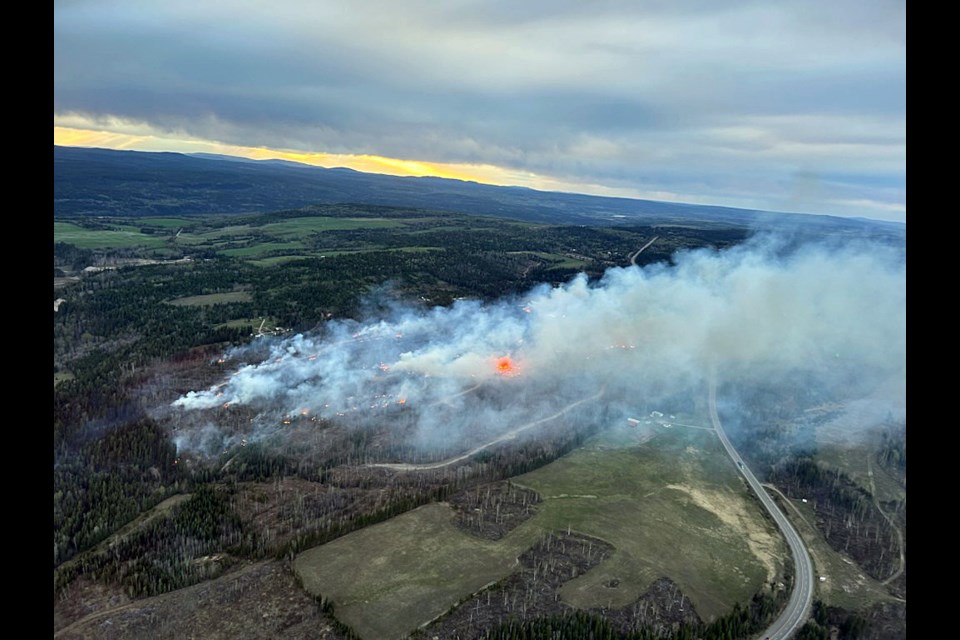Quick response by local volunteer firefighters and a bit of good fortune that diverted a crew of 20 BC Wildfire Service firefighters to the Hixon fire prevented it from being turning into a monster.
Whipped by winds that gusted to 40 kilometres per hour, the Naver Creek fire quickly grew to 70 hectares in the warm and dry conditions by Friday night. Despite the threat to several properties in the area that prompted an evacuation order and alert, no structures were burned, nobody was injured and by Monday morning the fire was contained.
The alerts/order that affected about 10 properties have been rescinded.
“It is completely contained, we have a fire guard all around it and we’re bringing in some heavy equipment just to pull all the piles apart and put the fires out that are remaining fires,” said Thompson.
Fueled by slash piles left by logging operations, flames were visible from Highway 97 as southbound motorists made their way down the long hill. It was all hands on deck for Hixon Volunteer Fire Department chief Gerald Thompson and his crew of 14-20 in a joint response with the Red Rock-Stoner and Buckhorn volunteer firefighters. BC Wildfire immediately sent air tankers and helicopters with buckets to douse the blaze.
“We had structural protection on one property right close to the top of the hill (Doucette Farm) for three days,” said Thompson. “We had water bladders and sprinkler and we were supporting the bladders (2,500 gallon tanks) from our tenders. We could fill it and go away from an hour and come back, so it gives you come time, and we got some forever water out of the creek.”
The fire started at the north end of Woodward Road and got to within 50 metres of the farmhouse. Thompson said it was fortunate there were three roads in the area of the fire, which made it much easier to put up a fire guard.
Suspected to be human-caused, it was the largest fire Thompson has had to deal with in 14 years as a volunteer firefighter, three years as the Hixon chief.
“It burned up the hill into an old logging block that had 30 to 40 piles from the logging process, so then it started burning them up, and then you get the wind behind the brush pile,” said Thompson.
He said the air water bomber support from BC Wildfire was a huge difference-maker in knocking down the fire quickly. Dunkley Lumber, southeast of Hixon, sent an 18,000-gallon water truck.
“Props should go out to BC Wildfire and the crew that was coming into town from Lytton, they responded to the fire and are still here today,” he said. “They’re amazing firefighters and did a great job.”
The Hixon department had scheduled an open house for Saturday at the fire hall and went ahead with the event, despite the fire. By that time it appeared it was becoming less of a threat and Thompson said his firefighters needed a break after two long intense days fighting the blaze.
“We narrowed it down to where we only just three or four staff on the fire so we could decompress a bit and it was a good turnout, we carried on and cooked over 200 hamburgers for the community,” “said Thompson. “It gave us a chance to feed the firefighters up on top of the hill and brought some hamburgers. The community really pulled together for it.”
Hixon is home to about 200 people and the area has about 520 residents.
This was the first fire of the season in the Prince George Fire Zone and it certainly had the potential to erupt into a massive blaze considering it happened after two warmer-than-usual days when the high temperature reached 27 C with very little humidity.
Having so many firefighters, including the volunteers, rapidly deployed soon after the fire was reported was the key to it not spreading more than it did, said BC Wildfire Prince George Fire Centre fire information officer Karley Desrosiers.
“We have initial attack crews prepared to respond at all times and certainly having them so close and so many of them was great, a bit of a fluke, but it was a group effort,” said Desrosiers.
“There’s around 25-to-30 slash piles within the fire perimeter and those are likely to continue to burn so smoke will continue to be emitted but we haven’t had any growth since the night the fire started. The wind was a major factor this weekend.
“With the passage of the cold front through the weekend, bringing stronger erratic gusty winds, as it stands right now we’ve seen a number of grass fires start and grow really quickly, just because everything is so dry.”
Fire risk remains high in the northeast, including Dawson Creek, Fort St. John and Fort Nelson. Twenty-eight fires have been reported to the Prince George Fire Centre from April 27-May 3 and 13 of them were in the Dawson Creek Fire Zone. All but one are under control are being held as of Monday, which Desrosiers attributes to the rapid responses of initial attack crews.
Telus crews were forced to make repairs after a number of power poles were burned in a fire that supplies the internet connection to Tumbler Ridge.
“We had five fires detected Wednesday (April 30) along Highway 52 and four of them ended up merging and we believe it was one of the small ones along the highway, the northernmost one, that damaged power poles and infrastructure,” said Desrosiers.
If you spot a wildfire, call the BC Wildfire Service immediately at 1-800-663-5555 or from a cell phone call *5555.



